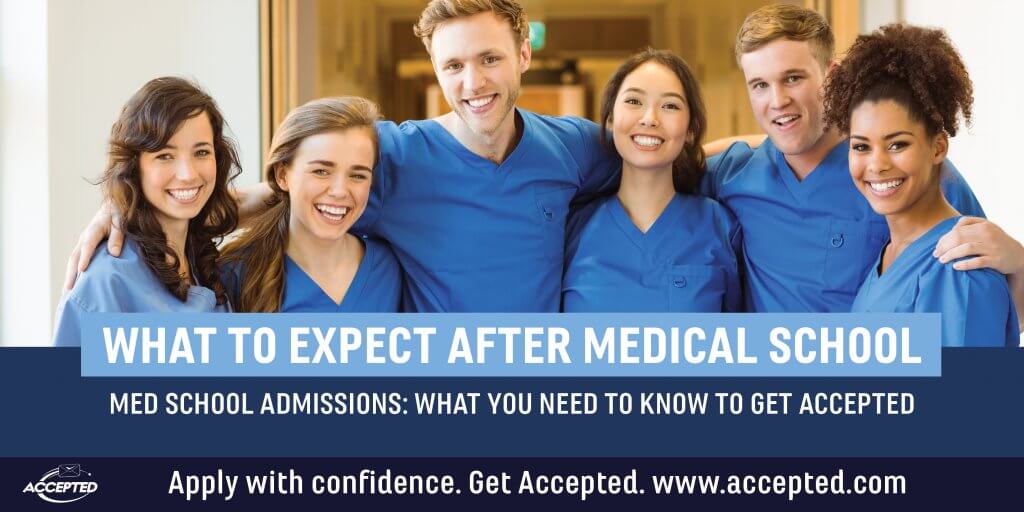

For this section of our What to Expect After Medical School series, I’ll provide a brief run-down of what happens after you graduate from medical school. As you have probably realized by now, medicine requires a commitment to lifelong learning. There will always be new procedures, new medications, and new lab tests to learn about. Treatments we once thought were going to be around forever will fade away.
As my anatomy professor once said, “50% of what you learn in medical school will be useless; the only problem is, we don’t know which 50%.” Your job is to keep replenishing your knowledge base. The years after medical school are when your knowledge begins to take root and fly. This is when you figure out that the main purpose of medical school was teaching you how to learn.
The rest is up to you.
From Medical School to Your First “Real” Job
You don’t just graduate from med school and then apply for a job. Let’s take a look at the different stops you’ll take along the way.
Phase 1: Internship Year
Some programs call interns a PGY-1 (post-graduate Year 1). You do have an MD or DO after your name, but you are not yet licensed by your state (you need a licensed resident to sign all prescriptions and supervise you during procedures).
There are three basic types of internships, and some residencies accept interns from more than one type. Check with the AAMC and ERAS for current requirements.
• Categorical: A categorical internship is embedded in a residency and does not require a separate application. You are accepted for a residency and complete your entire training, including internship, in that program. Internal Medicine, Pediatrics, Family Medicine, Emergency Medicine and Ob-Gyn are managed this way. Some General Surgery programs also accept applicants for the full training. A categorical internship may expose you to other fields of medicine, however it primarily gives a strong foundation in your chosen specialty.
• Transitional: Some specialties require a transitional internship, which you apply separately to in ERAS, and might have to do at another institution from where you complete your residency. The drawback of this is having to pick up and move two times. The benefit is you experience both medical and surgical practices and gain the skills needed to take and pass the USMLE Step 3. More programs these days are offering transitional years at the same location you do a residency, so there is less need to move a second time.
• Preliminary: These internships are similar to the transitional year, but instead of rotating through various specialties, you focus on either surgery or medicine. Some surgical subspecialties require a preliminary surgery internship (e.g., Urology), while medical specialties (e.g., Neurology) require a medical internship. Some specialties (e.g., Anesthesia, Dermatology) accept either one. Many institutions offer more preliminary internships than residency spots (cheap labor), so interns who have not been accepted to residency can work hard and hope for acceptance (or at least a good letter of recommendation) the following year.
Phase 2: USMLE Step 3
Generally taken at the end of the internship year, Step 3 assesses your grasp of clinical concepts relevant to patient care. These concepts include knowledge of human growth and development, disease states, and clinical skills. Through patient case scenarios, the exam tests your ability to formulate a diagnosis based on the history, physical exam, and lab findings, and then how to manage a patient. Passing Step 3 is a prerequisite for licensing by most state licensing boards.
Phase 3: Residency
Different specialties take more time to create a full-fledged doctor. Family Medicine, Internal Medicine and Pediatrics are three years; Psychiatry and Ob-Gyn are four years; General Surgery is five years. Refer to the AAMC for the training requirements of other specialties.
As you progress through the years of PGY-1, 2, 3, etc., you can expect to gain more confidence and responsibility. By your last year, you should be able to admit, treat, and discharge patients on your own, and do many procedures without supervision. You should also know when to consult someone from another specialty, and when to confer with a more experienced person in your own field.
Phase 4: Presentations at Professional Conferences
You will begin to present cases at M+M (morbidity and mortality) conferences, which sometimes feels like a public confessional. The upside of this process is that you will learn that other MDs have faced similar clinical challenges. While other physicians may suggest what you could have done differently (Monday morning quarterbacking), they will confirm that you did the best you could do. Most residencies see M+Ms as an essential learning experience, as it encourages physicians to get in the habit of disclosing, rather than concealing, errors in judgment. This allows you to get feedback on ways to manage a situation in the future, and it allows other physicians, residents, and students to learn from your experience and hopefully not make a similar mistake.
Phase 5: Specialty Board Exams
If you’ve ever wondered where the term “Board Certified” comes from, it is granted by each medical specialty board after passing this final exam. Some specialties give a written exam; others utilize an oral exam; and some require that you collect a case list of patients in your first two years of practice, which you then submit and discuss during your oral boards. It is considered a high honor and is generally required to maintain your board certification status through ongoing training and CME (continuing medical education). Some boards also require that you take a recertification exam every few years.
Phase 6: Extra Education
There are basically two options here:
• Fellowships: Many specialties offer “sub-specialization” in the form of a fellowship. This usually requires another 1-3 years of training. Depending on the length of your residency, you will start applying to fellowships sometime before your last year.
• Additional degrees: Some MDs will go on to pursue additional degrees such as MBAs, MPHs, JDs, and PhDs.
Phase 7: Applying for Jobs
Once you have completed your residency and/or fellowship, it’s finally time to apply for your first real job! Years ago, many physicians decided to hang up a sign and go solo, but these days most doctors join established groups. This allows you to share resources, on-call shifts, and collective wisdom. If you join a small group, you will need training in business practices, legal contracts, and financial issues. If you join a larger group or a university, these are often handled for you by a human resources department.
Here are some of the many options available to you after you finish training:
• Private practice – individual
• Private practice – small group
• Community clinic – often focus on patients with no or minimal insurance
• Public health – County health or CDC career
• Single specialty group – for example, ER, anesthesia, etc.
• Multi-specialty group – variety of primary care and specialties
• Academic medicine – may be clinical or research focused
• Research based – clinical vs. basic science
• Emerging career options:
• Hospitalist – does not have an outpatient site
• Telemedicine – sees patients online
• Concierge medicine – sees patients in their home
Phase 8: Post-Training
Physicians in every type of specialty must stay current with new research and methods that arise throughout their careers. If keeping your brain active is good for you, then medicine is truly a brain-healthy pursuit. Through a combination of CME (continuing medical education), board recertification, and special training in new diagnostic and treatment options, there are many ways to stay up-to-date.
You can draw on a variety of publications, colleagues, and online resources. At times, you may be swayed by the pharmaceutical and medical device industry to try new products, while at others, you may stick to the ones you know best. You may find it challenging to keep on top of the many new innovations that emerge each year. In the past decades, we have seen the advent of electronic medical records, motivational interviewing, and robotic surgery, just to name a few. The wise physician walks a path that is open to both the old and new.
Maintaining Work-Life Balance Throughout These Phases
With all this new information coming at you, you will also need to find new ways to combat the effects of stress. We know that chronic, lifestyle-related diseases are amplified by the stress hormone, cortisol, and it is apparent that physicians are not immune to the effects of stress. Perhaps the greatest thing you will discover is how to forge a balance between a career in medicine and life. By making your health a priority, you will be better able to show your patients how to preserve their health when they need to make similar changes.
The ways in which you cope with stress will likely change over your lifetime, as do the stressors themselves. Whether you focus on diet, exercise, relaxation, art, music, meditation, or some other pursuit, figuring out how to reduce stress will certainly make you a better doctor.
For many physicians, teaching is a great way to your keep one’s knowledge current and is not limited to those working in academic settings. Almost anyone can volunteer their time to teach residents, med students, premeds, nursing students, or medical assistants. As a time-honored and effective way of paying it forward, this is the perhaps the best way we have of training competent, compassionate, and skilled providers. The bonus? You are guaranteed to learn as much from them as they will from you.
So, what’s next for you and how can you achieve your goals? Work one-on-one with an expert advisor who will walk you through the process of deciding what steps to take next, applying to relevant degree programs/internships/residency programs/fellowships, etc., and getting ACCEPTED. View our Admissions Consulting Services for more information.
 Suzi Schweikert is a former UCSD School of Medicine adcom member who has mentored students in healthcare programs for over 20 years. She has a BA in English Lit from UCLA, an MD from UCSD, and an MPH from SDSU. Want Suzi to help you get Accepted? Click here to get in touch!
Suzi Schweikert is a former UCSD School of Medicine adcom member who has mentored students in healthcare programs for over 20 years. She has a BA in English Lit from UCLA, an MD from UCSD, and an MPH from SDSU. Want Suzi to help you get Accepted? Click here to get in touch!
Related Resources:
• All You Need to Know About Residency Applications and Matching
• Keeping Up with Dr. Andrea Tooley – Ophthalmology Resident and Soon-To-Be-Fellow, a podcast episode
• Residency Admissions: How to Match as a Couple
The post What to Expect After Medical School appeared first on Accepted Admissions Blog.


No comments:
Post a Comment